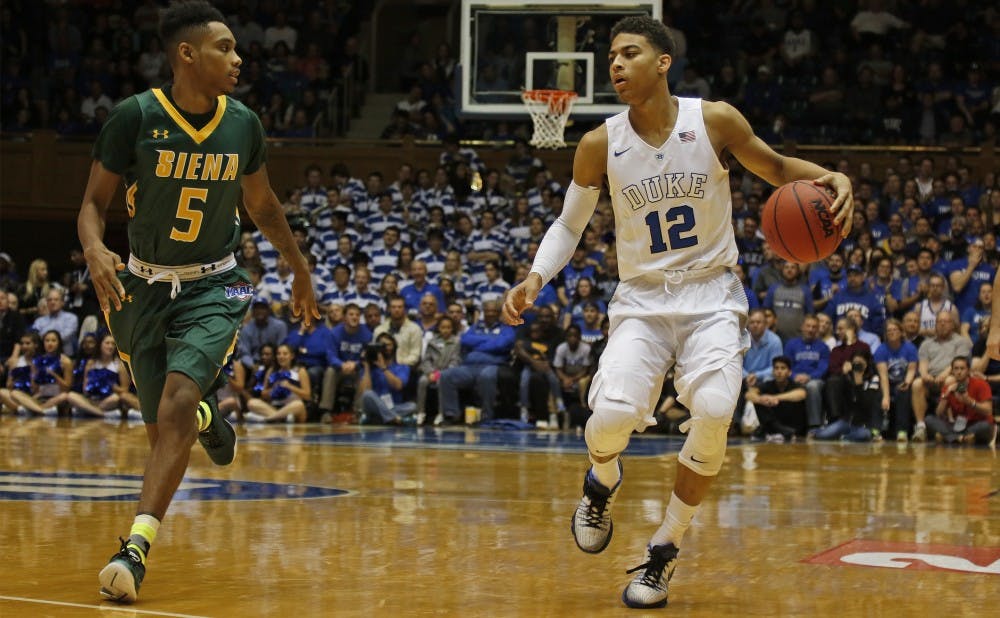Last year at this time, Duke fans were still basking in the glory of a national championship. Although Tyus Jones, Jahlil Okafor and Justise Winslow had already announced their departures for the NBA draft and would never play another game in a Duke uniform, their names were forever etched into the minds of the Blue Devil faithful as heroes for their magical work in Indianapolis.
About filling their spots? Not to worry—within three weeks of defeating Wisconsin, Duke secured the commitments of five-star recruits Brandon Ingram and Derryck Thornton to lock in the No. 1 ranked recruiting class for the second straight year. The smiles of Duke fans returned as they envisioned Thornton stepping into the shoes of Jones and orchestrating the offense, one centered around Ingram and his versatility creating nightmares for opposing defenses.
This time around, the picture is not all that different. The Cameron Crazies celebrated the outcome of the national championship—albeit because of a crushing North Carolina loss, not a Duke victory—and can sleep well at night with yet another top recruiting class on the way to Durham in the fall.
And once again, those highly touted recruits from the previous year will not be back. Ingram, as expected, took advantage of his unique skill set and solid tournament performance to enter the NBA draft, where he is likely to be one of the top two selections come June. The Kinston, N.C., native is now the seventh one-and-done in the past six years to use Durham as a pit stop on his way to NBA riches.
Thornton, in a less anticipated move, is leaving Durham for a different reason altogether—in his words, “to pursue the opportunity to play college basketball closer to home.” This marks the third straight season the Blue Devils have had a player transfer out of the program, with Thornton featuring much more prominently on the floor than fellow transfers Alex Murphy and Semi Ojeleye.
Maybe Thornton—who less than 12 months ago reclassified to the Class of 2015 to come play for Duke head coach Mike Krzyzewski—truly missed the West Coast and felt more comfortable there. At first glance, it doesn’t seem to add up that such a talented player would want to transfer after averaging more than 25 minutes per game as a freshman. With plenty of opportunities to grow in the next three seasons under the guidance of one of the nation’s elite coaching staffs, Thornton could have taken his game to the next level.
Maybe Thornton saw the writing on the wall—with Grayson Allen coming back for his junior season, the addition of five-star combo guard Frank Jackson and holdovers Matt Jones and Luke Kennard, the Duke backcourt will be very crowded in 2016-17. The Blue Devils won’t need to play as many guards as they did this year, thanks to one more year from team captain Amile Jefferson, swingman Jayson Tatum and the 6-foot-9, 230-pound frame of No. 1 recruit Harry Giles bolstering the frontcourt. Throw in the potential commitment of five-star center Marques Bolden—who remains split on his decision—and the Blue Devils would be squeezed for both scholarship spots and playing time.
The other school Bolden has supposedly narrowed his choice down to? Kentucky, a program that Duke is converging toward at an alarmingly fast rate, if it has not reached that level already. It may have once seemed inconceivable to mention the Blue Devils and the Wildcats in the same sentence without “rivals” thrown in somewhere, but now the similarities between the two are undeniable. Recruit the very best talent in the country, and disregard the fact that some of those players have no intentions of staying for more than one season, because there will always be another wave of five-star high school recruits hungry to follow in their footsteps.
There’s nothing in the rules against this, of course. It’s just a philosophical choice on how to best build a winning team year in and year out, and it’s hard to argue that it doesn’t work when you can recruit as well as Krzyzewski and John Calipari do. Duke and Kentucky have claimed three of the past six national championships, and were contenders in the years they did not.
But it’s certainly not the only way to construct a championship-caliber squad. The last two national runner-ups, Wisconsin and North Carolina, are perfect examples of well-balanced teams that matured together over the course of multiple seasons. They became great teams not necessarily because of great talent—and this is not to say those teams lacked individual skill—but rather due to an ability to become more, collectively, than the sum of their parts. That ability is not recruited, and not one that can be cultivated in nine months.
Ultimately, both of those teams fell just short of the championship peak. They came agonizingly close, and truly were deserving of a national title. The Duke fan in me was happy to see those teams fall, but my inner sports fan was certainly not.
As mercurial as Thornton was on the court this season—the seemingly endless stream of midrange jumpers and head-scratching mental mistakes mixed in with the occasional and tantalizing, ‘How did he just do that?’ play—I was sad to see him leave. Are the Blue Devils going to be noticeably worse next season because he’s gone? Probably not. But it just won’t feel the same.
Get The Chronicle straight to your inbox
Signup for our weekly newsletter. Cancel at any time.

